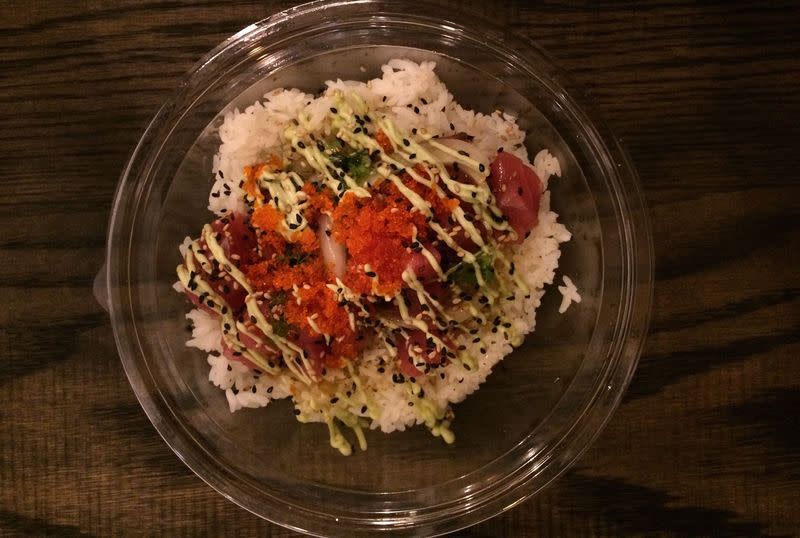Why Poke Is Already the Trendiest Food of 2016
The first thing you have to know about poke is that it’s pronounced “poh-kay.” If you’re from Los Angeles or have ever caught a mad wave in Hawaii, you probably already knew this; if you’re from anywhere else, chances are you have no idea what I’m talking about. But if my predictions for the Trendiest Food of 2016 are anywhere near true, you’ll know all about it by the end of the year.
Related: This Year’s Food Trends, According to Our Kids and Grandparents

Ahi tuna poke from Wisefish Poke. (Photo: Leslie Stephens/Food52)
Named for the Hawaiian verb, “to slice or cut,” poke traditionally refers to any raw fish, typically tuna, that’s been cut into cubes. Chung Chow executive chef and co-owner of Noreetuh, a Hawaiian-inspired New York restaurant, explained, “In the modern context, it can refer to cut cubes of fish, vegetables, or meat—usually cured.” While it’s traditionally served with minimal garnishes—Chung cited just salt and sesame oil—modern iterations of the poke are often served over rice with soy sauce and a number of toppings from furikake to jalapeños. “In California,” Chung told me, “the diversity of poke available is endless.”
Related: Too Many Cooks: Food Trends That Just Won’t Die
A photo posted by noreetuh (@noreetuh) on Nov 15, 2015 at 7:24am PST
(Instagram: @noreetuh)
It’s only been a few years since the first poke spots started popping up in the West Coast, but Californians have already adopted the dish as their own, often served over rice as a “poke bowl.” More recently—within the past year, or so—poke, and Hawaiian food in general, has headed even further east to New York, with Onomea in Brooklyn and Chung’s restaurant, Noreetuh in the East Village.
Related: Toast is Not Just a Passing Trend
Last night, in a very un-beachy, post-Jonas New York, Wisefish Poke, opened in Chelsea as one of the first casual grab-and-go poke place in the city (though several are slated to open this year). Co-owned by two non-Hawaiian poke-lovers, the concept arose from a craving. Wisefish’s co-owner, Drew Crane, told me over the phone, “During a trip to Hawaii, poke hijacked my vacation—I became enamored with it. When I came to New York and couldn’t find it, the idea to open Wisefish got its start.”
Related: Croissant Donuts, Made at Home
A photo posted by @wisefishpoke on Jan 23, 2016 at 7:50am PST
(Instagram: @wisefishpoke)
Behind that passion is also a keen sense of business savvy. Drew and his co-owner Bryan Cowan both come from business backgrounds (Goldman Sachs and Columbia Business School, respectively). Poke bowls are, depending how you look at them, a safer bet than many on Wall Street: They encompass two of the arguably most trendy foods of all time, sushi (circa 1980s) and grain bowls (circa 2008).
Related: These 7 Chiles Are So Hot Right Now (& Why You Should Care)
“When sushi became popular in the 1980s,” Chung said, “people didn’t eat raw fish. But now people are more accepting of it and are seeking it out.” While some Hawaiian flavors are not received as well, Chung said that his customers have found a familiarity in the flavors in the poke. As Drew puts it, “It has similar flavor profiles to sushi, but is served in a more convenient way.”
Related: Why the Best Sushi isn’t Fresh (and 5 Other Tips from One of New York’s Best Sushi Chefs)

Your new favorite weeknight meal. (Photo: James Ransom/Food52)
Last night I grabbed a friend to try poke bowls for ourselves. My bowl, a mix of ahi tuna, sweet onion, tobiko, and wasabi avocado cream sauce was the salad I always wanted: A spicy, umami-rich heap of rice and protein (with no lettuce in sight—no offense, lettuce). Trend or no trend, easy to see why the bowls have caught on so quickly. I’ll be making poke again before the snow melts.
Some Poke Combinations to Try:
Brown rice + Ahi tuna + tobiko + ginger-garlic soy sauce
Zucchini noodles + salmon + avocado + wasabi aioli
Soba noodles + raw tofu + herbs + ponzu sauce
White rice + cucumber + furikake + spicy mirin sauce
By Leslie Stephens.


